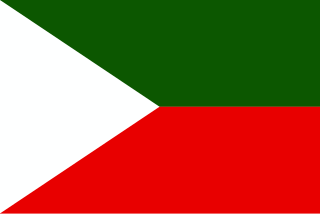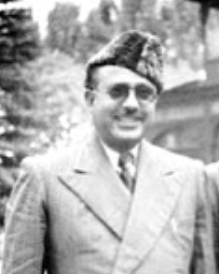Related Research Articles

Kotli District is a district of Pakistan-administered Azad Kashmir in the Azad Kashmir region. It is one of the 10 districts of Pakistan's dependent territory of Azad Kashmir. It is bounded on the north by the Sudhanoti District and the Poonch District, on the north-east by the Poonch District of Indian-administered Jammu and Kashmir, on the south by the Mirpur District and the Bhimber District, and on the west by the Rawalpindi District on Pakistan's Punjab Province. It is the biggest district of Azad Kashmir by population and the second biggest by land area, after the Neelum District. The district headquarters is the city of Kotli. Kaladab The main native languages are Pahari, and Gujari.

The Jammu Kashmir Liberation Front (JKLF) is a formerly armed, political separatist organisation active in both the Indian-administered and Pakistani-administered territories of Kashmir. It was founded by Amanullah Khan, with Maqbool Bhat also credited as a co-founder. Originally a militant wing of the Azad Kashmir Plebiscite Front, the organization officially changed its name to the Jammu Kashmir Liberation Front in Birmingham, England on 29 May 1977; from then until 1994 it was an active Kashmiri militant organization. The JKLF first established branches in several cities and towns of the United Kingdom and other countries in Europe, as well as in the United States and across the Middle East. In 1982, it established a branch in the Pakistani-administered territory of Azad Jammu and Kashmir, and by 1987, it had established a branch in the Indian-administered Kashmir Valley.

The Kashmir conflict is a territorial conflict over the Kashmir region, primarily between India and Pakistan, and also between China and India in the northeastern portion of the region. The conflict started after the partition of India in 1947 as both India and Pakistan claimed the entirety of the former princely state of Jammu and Kashmir. It is a dispute over the region that escalated into three wars between India and Pakistan and several other armed skirmishes. India controls approximately 55% of the land area of the region that includes Jammu, the Kashmir Valley, most of Ladakh, the Siachen Glacier, and 70% of its population; Pakistan controls approximately 30% of the land area that includes Azad Kashmir and Gilgit-Baltistan; and China controls the remaining 15% of the land area that includes the Aksai Chin region, the mostly uninhabited Trans-Karakoram Tract, and part of the Demchok sector.

Ghulam Mohammed Sadiq was an Indian politician, who served as the Prime Minister of Jammu and Kashmir from 1964 to 1965, when the position was renamed to Chief Minister. He continued as the Chief Minister till his death in 1971.

The Indira–Sheikh Accord signed in 1975 between Kashmiri leader Sheikh Abdullah and then Prime Minister of India Indira Gandhi, decided the terms under which Abdullah would reenter the politics of Kashmir. It allowed Abdullah to become Chief Minister of Jammu and Kashmir again after 22 years and enabled competitive politics in the State.

Jammu and Kashmir, also known as Kashmir and Jammu, was a princely state in a subsidiary alliance under British East India Company rule from 1846 to 1858 and under the paramountcy of the British Crown, from 1858 until the Partition of India in 1947, when it became a disputed territory, now administered by three countries: China, India, and Pakistan. The princely state was created after the First Anglo-Sikh War, when the East India Company, which had annexed the Kashmir Valley, from the Sikhs as war indemnity, then sold it to the Raja of Jammu, Gulab Singh, for rupees 75 lakhs.

The Haveli District is a district of Pakistan-administered Azad Kashmir in the disputed Kashmir region. It is one of the 10 districts of Pakistan-administered dependent territory of Azad Kashmir. It was previously a tehsil of the Bagh District but was elevated to district status on 1 July 2009.
Election for the Indian state of Jammu and Kashmir were held on 23 March 1987. Farooq Abdullah was reappointed as the Chief Minister.
Elections for the Indian state of Jammu and Kashmir were held over October 1983. The Jammu & Kashmir National Conference leader Farooq Abdullah was appointed Chief Minister.
Elections for the Indian state of Jammu and Kashmir were held over June 1977, which are generally regarded as the first 'free and fair' elections in the state. Jammu & Kashmir National Conference, newly revived from the former Plebiscite Front, won an overwhelming majority and re-elected Sheikh Abdullah as the Chief Minister.

Shigar District is a district of Pakistani-administered Gilgit-Baltistan in the disputed Kashmir region. That is also home for one of largest Mountain in the world. The district is bounded on the north by the Nagar District, the Hunza District, and the Kashgar Prefecture of China's Xinjiang Uyghur Autonomous Region, on the south-east by the Ghanche District, on the south-west by the Rondu District and the Skardu District, and on the west by the Gilgit District. The Shigar District was established in 2015, prior to which time it had been part of the Skardu District.

Gilgit Division is an administrative division of Pakistan-administered Gilgit-Baltistan in the disputed Kashmir region. Gilgit is the divisional headquarters of Gilgit Division. Since divisions were restored back in 2008, the division currently consists on six districts:

Baltistan Division is a first-order administrative division of Pakistan-administered Gilgit-Baltistan in the disputed Kashmir region. It overlaps with the historical Baltistan.
The Jammu Praja Parishad was a political party active in the Jammu Division of the Indian-administered Jammu and Kashmir. It was founded in November 1947 by the Rashtriya Swayamsevak Sangh activist Balraj Madhok, and served as the main opposition party in the state. It maintained close ties with Bharatiya Jana Sangh during its lifetime and merged with the latter in 1963. Its main activity was to campaign for the close integration of Jammu and Kashmir with India and oppose the special status granted to the state under the Article 370 of the Indian constitution. After its merger with the Bharatiya Jana Sangh, the precursor of the present day Bharatiya Janata Party, the party gradually rose in stature. As an integral part of the Bharatiya Janata Party, it was a partner in the ruling coalition led by the People's Democratic Party.
The Muslim United Front (MUF) was a 'polyglot coalition' of Islamic Kashmiri political parties that contested the 1987 Jammu and Kashmir Legislative Assembly election in the erstwhile Indian state of Jammu and Kashmir. The Jamaat-e-Islami of Jammu and Kashmir was a key constituent party of the coalition. The MUF won four Assembly seats in the 1987 election. However, widespread rigging of the election by the ruling National Conference party was reported. In the absence of such rigging, commentators believe that it could have won fifteen to twenty seats, a contention admitted by the National Conference leader Farooq Abdullah.
Elections for the Indian state of Jammu and Kashmir were held in February 1967. Ghulam Mohammed Sadiq was appointed Chief Minister of Jammu and Kashmir.
Elections for the Indian state of Jammu and Kashmir were held in the early months of 1962. Bakshi Ghulam Mohammad was appointed Prime Minister of Jammu and Kashmir.
The first elections for the Legislative Assembly of the Indian state of Jammu and Kashmir under its own Constitution were held in March–June 1957. Bakshi Ghulam Mohammad was appointed Prime Minister of Jammu and Kashmir.
Elections for the Constituent Assembly of the Indian state of Jammu and Kashmir were held in September–October 1951. Sheikh Abdullah was appointed Prime Minister of Jammu and Kashmir. Following frictions with various groups such as the Jammu Praja Parishad agitation, Abdullah was dismissed in August 1953 and imprisoned. Bakshi Ghulam Mohammad was appointed as the next Prime Minister.
National Highway 144A is a national highway in the union territory of Jammu and Kashmir in India. NH-144A is a spur road of National Highway 44 that runs between Jammu and Poonch.
References
- ↑ Sumantra Bose, The Conversation, retrieved 13 March 2023.
- ↑ Bose, Sumantra (23 August 2007). "The partition evasion". openDemocracy . Retrieved 16 December 2007.
- ↑ "Sumantra Bose biography" (PDF). European Parliament . Retrieved 30 November 2008.
- ↑ "Sumantra Bose". London School of Economics. Retrieved 30 November 2008.
- ↑ Ganguly, Sumit (1 January 2007). "Sumantra Bose, Kashmir: Roots of Conflict, Paths to Peace". Journal of Cold War Studies. 9 (1): 144–146. doi:10.1162/jcws.2007.9.1.144. ISSN 1520-3972. S2CID 57558930.
- ↑ Hanif Siddiqi, Farhan (2004). "SAGE Journals: Your gateway to world-class journal research". Millennium: Journal of International Studies. 33 (2): 427–429. doi:10.1177/03058298040330020908. S2CID 220926198.
- ↑ Perry Anderson (2013). The Indian Ideology. Verso Books. pp. 177–178. ISBN 978-1-78168-259-3.
- ↑ Wirsing, Robert G. (2004). "Reviewed work: Kashmir: Roots of Conflict, Paths to Peace, Sumantra Bose". The International History Review. 26 (4): 906–908. JSTOR 40110632.
- ↑ Sumantra Bose (October 2017). "Transforming India: Challenges to the World's Largest Democracy (Review)". pacificaffairs.ubc.ca. Retrieved 10 February 2019.
- ↑ Kondo, Norio (2016). "Transforming India: Challenges to the World's Largest Democracy by Sumantra Bose, Cambridge, MA, Harvard University Press, 2013, 337 pp". The Developing Economies. 54 (1): 130–133. doi:10.1111/deve.12098. ISSN 1746-1049.
